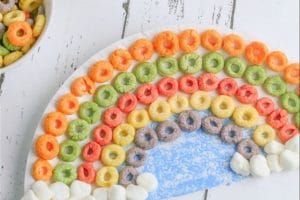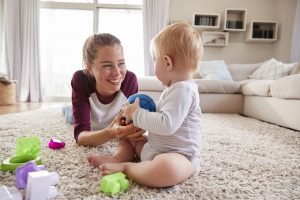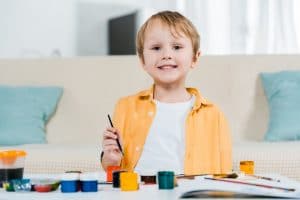Expert tips by Jan Jones (Early Childhood Educator)
Stages of creative development in babies/infants (0 – 15 months)
Pleasing others or being judged by others does not influence young babies – they are completely spontaneous in their actions and reactions. Maybe it could be considered that babies are truly creative.
“Children are creative when they are not trying to please others and are not being influenced by others. They are not influenced in traditional thinking and expectations.”
Children grow naturally – therefore, given the right environment most will grow into happy well-adjusted human beings. The carer’s rule is to enhance the setting and respond to their interests, answer their questions, cater for their energy and let them emerge as sound adults. With babies, creative perception is active and immediate – it is taking advantage of the moment.
Consider the following example:
A baby is on his tummy on a mat on the floor. He brings up some wind, and along with it a small amount of partly digested milk.
Now look at this from the baby’s point of view:
- “How interesting.”
- Feel it – “Mm, warm and wet.”
- Pat it – “Still wet but not as much there now.”
- Taste it “…”
Suddenly the carer scoops the baby up and the moment is over.
The baby is using all of his senses to explore his world and his actions were creative as far as he is concerned.
Babies use all their senses to explore their world to learn and to understand. A loving and caring environment secures and enriches the baby’s world and encourages laughter and learning. When you think of ‘creativity’ as being a form of self-expression that is enjoyable and gives pleasure, you will appreciate how much the senses are involved in everything a baby does. Development always occurs in several areas at the same time.
While being creative a child will also involve a number of motor skills:
- Exploring a simple obstacle course with different textures.
- Rolling a ball – with laughter and talk.
- Using toys that can be handled.
- Rolling on the mat and crawling over a pillow (and getting stuck and laughing).
- Catching a balloon, trying to sit on it, feeling its texture.
- Splashing in the bath, catching bubbles or playing in a basin of water.
Music experiences:
- Spontaneous singing when on the swing and in the sandpit, etc.
- Clapping with an adult.
- Listening and imitating the sounds all around them: birds, wind-chimes, other children playing.
- Banging with a spoon on the high chair tray.
- Playing with instruments.
- Copying the sounds an adult is making
- Encourage your child to hear the sounds of nature without background commercial music. Outdoor playtime does not need to be accompanied by music playing. ‘Music’ includes laughter, sounds of birds or wind. Talk to your child about all of the sounds you can hear.
Games and language:
- Looking for an adult hiding under a blanket.
- Reading and looking at pictures with an adult.
- Games such as “Who’s that in the mirror?”
- Playing peek-a-boo behind trees, etc.
Touch and feel:
- Exposing the child’s hand, face, feet to different textures.
- Using language to compare the warmth of a bottle at bedtime or the feel of mother’s breast.
- A snuggle with teddy as he/she goes to sleep.
- The warmth of a bath at the end of the day.
- The splash in the bath when his/her feet hit the water.
- The feel of sand as it runs through its fingers.
- The lumps he/she can make when the sand is wet.
Stages of creative development in toddlers (15 months to 2.5 years)
To develop creativity in children as they move into their second year, freedom of choice needs to be given. As in all areas of development, creative development does not stand alone. Given sufficient opportunities to experience new and well-tried activities and experiences, children will become creative in their own way.
Provide a variety of items that can be stacked, placed inside each other, used to dig or pour. Allow the child to make his/her own choices with these items. Whatever, he/she does, it will be his/her form of self-expression or creativity.
Give a two-year-old a cardboard box and watch their creativity emerge!
Below are some ideas that address the senses and can lead to creativity while meeting other developmental needs.
Sight
- This can be your face with different expressions, with a variety of movements, with different hats, etc.
- Pictures and mobiles above the child when in bed or over the change table.
- Coloured streamers on the open window – allowing movement from the breeze.
- Mirrors at child level or lift child up to the mirror.
- Clear, simple (laminated) pictures at their level, that they can touch and feel.
Hearing
- Gentle bells children can hear.
- Your voice singing a lullaby or song.
- The voice that you use when you greet, say good-bye, even your ‘baby speaking’ voice.
- Soft music at sleep time.
- Dance music when you dance with your child.
- Recordings of the child’s singing, chattering, crying, sounds of the environment.
- Recording of common animal sounds associated with pictures and language.
Touch
- Soft warm toys compared to clod glass in window.
- Rough texture of a carpet to smooth surface of a tiled floor.
- Finger paint with different textures.
- Water to splash in.
- Sticky substances or materials.
Smell
- Adult’s perfume.
- Food cooking in the kitchen.
- Fragrance of flowers in the garden.
- Smell of a lemon.
Taste
Taste is linked to smell. Toddlers are very aware of different tastes and often show strong likes and dislikes.
When an infant is introduced to a new food it is important that they are told the name of the food. Language development exists in all developmental areas.
How do you encourage your baby to make full use of their senses during playtime?













